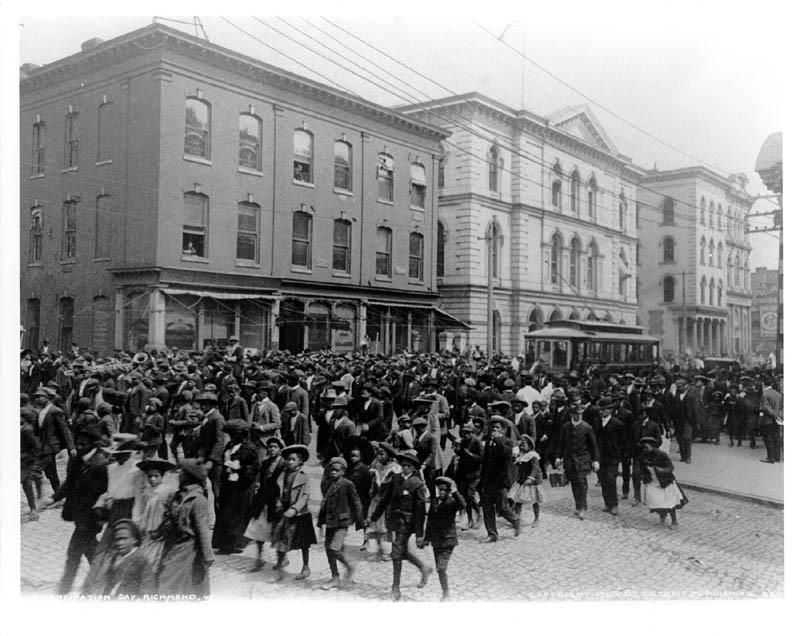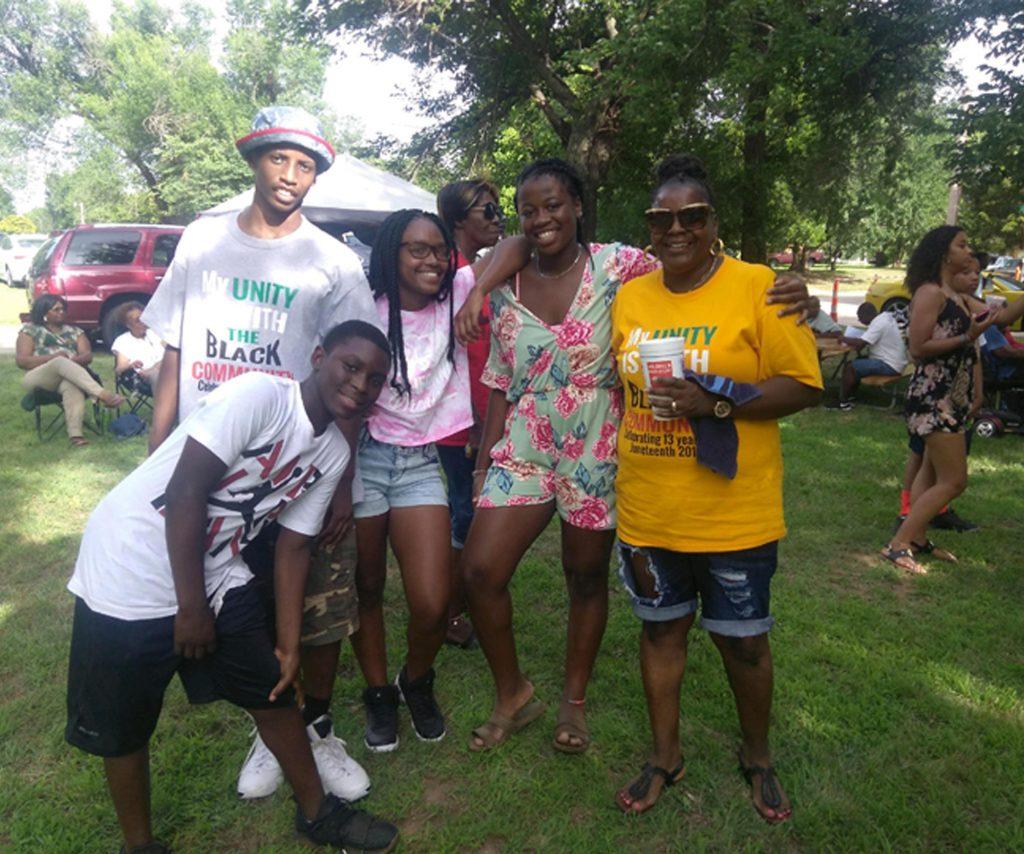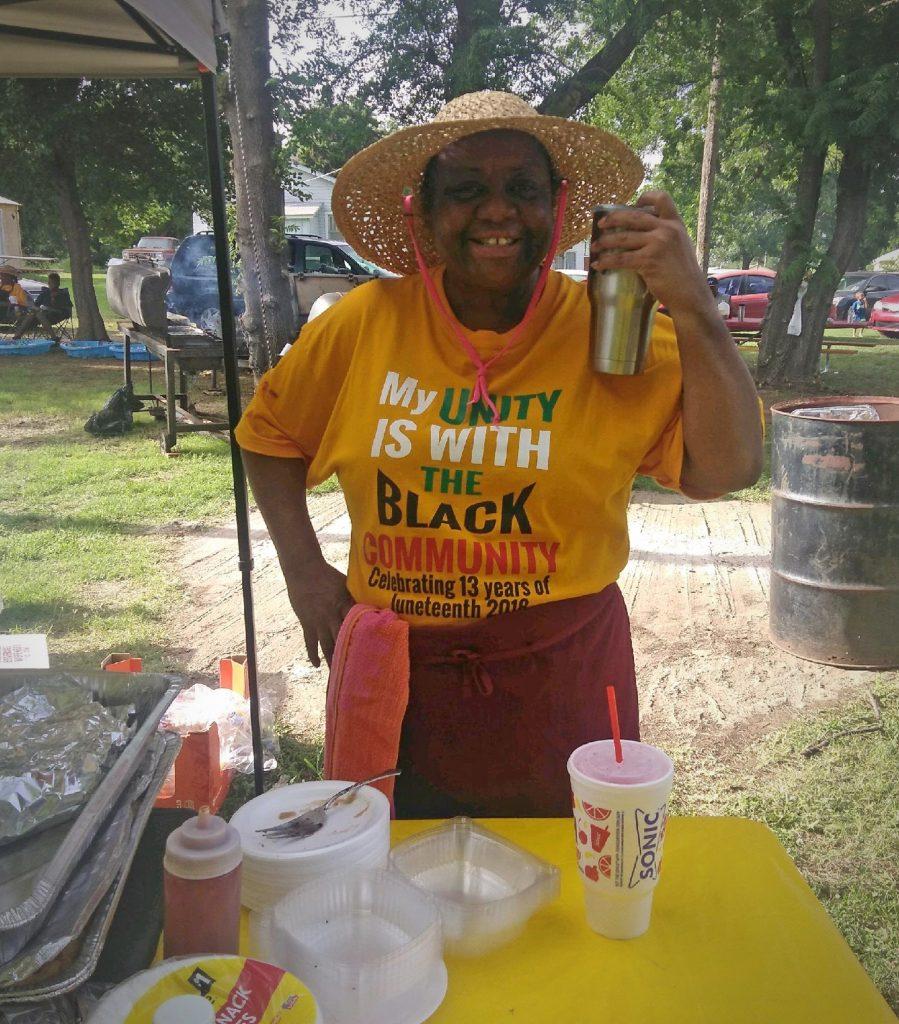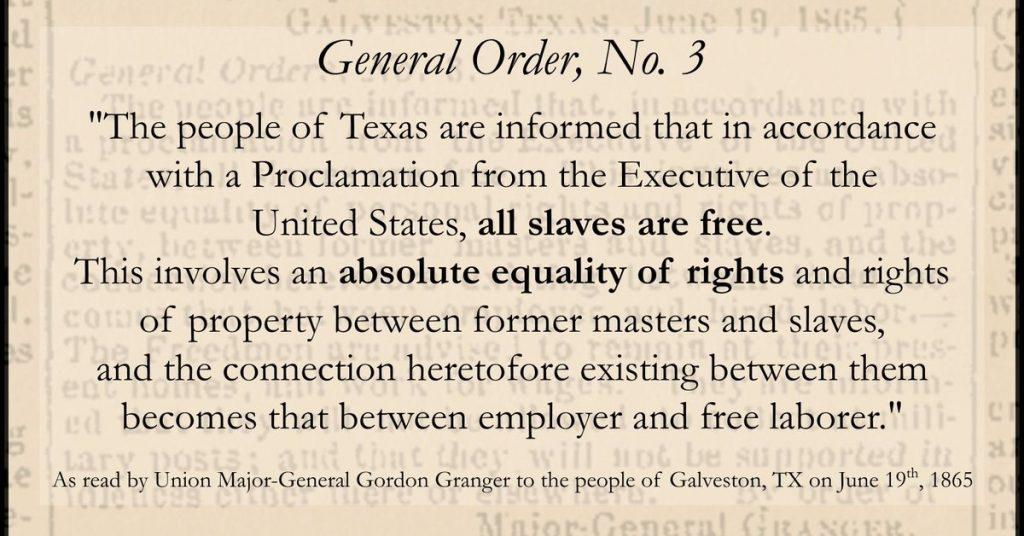Story by Abby Grey and Norman Grey
Stepping Stones Toward Freedom
While there is a fast-growing awareness and knowledge about the holiday that has come to be called Juneteenth, there is still considerable reason to explore its history and meaning, so that it can be fully understood. Traditionally, it has been a holiday of special meaning to African-Americans, but it is receiving more and more significance from other Americans.
During the civil war, on September 22, 1862, President Abraham Lincoln issued the Emancipation Proclamation. The proclamation became effective on January 1, 1863. The Proclamation read in part: “all persons held as slaves within any State or designated part of a State, the people whereof shall then be in rebellion against the United States, shall be then, thenceforward, and forever free. And the Executive Government of the United States, including military and naval authority thereof, will recognize and maintain the freedom of such persons, and will do no act or acts to repress such persons, or any of them, in any efforts they may make for their actual freedom.”

Lincoln went on to designate all States, or parts of States, that the Proclamation applied to. Being a State of the Confederacy, Texas was considered part of this proclamation.
Several problems with Lincoln’s Proclamation having the desired effect in Texas—First, Texas did not consider itself a state that belonged to the Union. Jefferson Davis was considered President of the Confederacy, so Lincoln’s power did not extend to this far-south state. Second, the war was not even over, so they did not see a reason to abide by Lincoln’s Proclamation. The biggest obstacle to the release of the news was the fact that slaveowners felt no need to inform their slaves of any Proclamation. They were necessary to run their farms, plantations, and businesses profitably; so, the temptation for slaveowners to withhold the news was an easy decision. This lack of access to the information regarding their freedom set by the proclamation became a replacement to the chains that bonded them for hundreds of years. What you don’t know won’t hurt you, in most cases…for the slaves residing in Texas from 1963-1965, this lack of knowledge created a gap in obtaining their rightful freedom.

It was not until June 19, 1865, nearly 2 ½ years after President Lincoln issued the Emancipation Proclamation, that Union Army Major General Gordon Granger arrived in Galveston, Texas, proclaiming that all slaves were free! General Granger read his General Order No. 3 at the Osterman Building (what is now called “The Strand” in downtown Galveston). The Osterman Building became the Union Army Headquarters in Galveston. Under the Emancipation Proclamation, representatives of the Union Army and Navy were authorized to issue these orders. It was reported by The Texas Historical Commission and The Galveston Historical Foundation that General Granger’s troops marched throughout downtown Galveston reading General Order No. 3. The Osterman Building was demolished, but a monument stands in its place to commemorate the reading by General Granger, on June 19, 1865. Thus, Galveston, Texas became the birthplace of what is now known as Juneteenth!
Losing Battles to Win a War
Nothing captures the heart and soul of the importance of Juneteenth to African-Americans better than this simple, powerful statement attributed to former slave Felix Haywood in 1865:
“We was all walkin’ on golden clouds…We was free. Just like that, we were free!”
Remnants of slavery and inequality often offered impediments to Juneteenth celebrations. In many cities, black people were not allowed to use city parks for the celebration because state-sponsored segregation prohibited the use of public facilities by them. In 1872, black leaders in Texas purchased 10 acres of land in Houston on which to celebrate Juneteenth each year. This land is now known as Houston’s Emancipation Park. Outside of the town of Mexia (west of Waco) in Limestone County, Texas, Booker T. Washington Park was established in 1898 for Juneteenth celebrations. Crowds numbering 30,000 or more gathered there each year for the festivities.
However, even in this atmosphere of growing importance and popularity of Juneteenth celebrations among African-Americans, political and social factors in different parts of the country started to stunt the growth of celebrations in the early 20th century. Texas and other former Confederate states began to modify their state Constitutions in ways that disenfranchised black people, denying them the ability to establish political power. State legislatures passed Jim Crow laws to ensure that black citizens were nothing more than second-class citizens, even though the intent of the 13th, 14th and 15th Amendments, passed in the 1860’s, provided otherwise. Upwardly mobile African-Americans that aspired for better lives felt it was counterproductive to associate themselves with celebrations that reminded others of their slave past. Younger generations of African-Americans were occupied with things that would improve their lives, such as education. The many African-Americans that migrated to the North to find better-paying non-agricultural jobs often couldn’t take time off or simply wanted to concentrate on the future, rather than the past.

Later, after the Great Depression, many African-Americans were forced off farms into urban areas to find work. They found it more difficult to take time off of work for celebrations in an urban environment.
In Texas after World War II, the Texas State Fair at the fairgrounds in Dallas, became the primary meeting place for the Juneteenth celebration. This location allowed the massing of 200,000 people or more for the celebration and led to the revival of the celebration in Texas! From the end of World War II until about 1970 a great migration of black people from Texas, Louisiana and other Southern States to the North and West took place. It is said that they took the Juneteenth celebration with them to these places when they arrived. When Wesley Johnson, an immigrant from Texas, arrived in San Francisco, California, in 1945, he educated that City about the history and significance of the Juneteenth celebration in Texas and it has been celebrated there ever since. One man can make a difference!
In the late 1950s and the 1960s, African-American attention turned to the movement for equality under the law, The Civil Rights Movement. As a result, the interest in Juneteenth, and what it stood for waned for a brief period. African-Americans were certainly appreciative to be free from slavery, but they felt that they had patiently waited for equality and integration into society long enough. President John F. Kennedy, and his brother Robert Kennedy, who was Attorney General of the United States, together with several other national leaders believed it was time to finally do something about racial discrimination in America and began promoting the idea of the passage of federal legislation to ensure equality and equal protection of the law as provided for in the Constitution. However, it seemed doubtful that there was sufficient support in Congress to pass such measures.
Somehow it took tragedy to move those in power to take the necessary action. That tragedy was the assassination of President John F. Kennedy in Dallas, Texas on November 22, 1963. Kennedy’s successor in office, Lyndon Baines Johnson, became the very unlikely torch-bearer in the passage of The Civil Rights Act of 1964 and The Voting Rights Act of 1965. Johnson, who earlier in his career in Congress was known for being a staunch segregationist and someone who did not give high priority to race issues, made it his top priority to pass the Civil Rights Act and the Voting Rights Act that the fallen President Kennedy wanted so much to achieve. Johnson, who had won the Presidency in 1964 over Barry Goldwater in one of the greatest landslides in history, fell into great disfavor in the South because of his role in the passage of those laws, and it was that, and his bungling of the disastrous Vietnam war that convinced him he could not win if he ran for re-election in 1968. With the passage of those civil rights laws, black people began tying Juneteenth to the civil rights gains. Freedom from slavery was irrevocably woven into achieving true equality under the law, for without equality, people cannot truly be free. Thus, there was a revival of Juneteenth celebrations again.
Campaigners in the 1968 Poor People’s Campaign in Washington D. C., led by Reverend Ralph Abernathy, which was a campaign for equality wore Juneteenth buttons to show solidarity between the equality movement and the Juneteenth celebration. Large Juneteenth celebrations started occurring in cities like Minneapolis and Milwaukee in the upper Midwest and across the Eastern United States. Milwaukee reported drawing over 100,000 attendees in 1978. Houston began holding large celebrations again in 1974, and 30,000 attended a celebration in Fort Worth’s Sycamore Park in 1975.
In 1979, Texas State Representative Al Edwards of Houston successfully sponsored legislation to make Juneteenth an official Texas state holiday, the first state to establish such a day. Edwards started an annual Prayer Breakfast and Commemorative that same year. He established the Ashton Villa in Galveston as the venue of this annual event. The reason he chose this venue was that local folklore has it that Ashton Villa was the actual site that General Granger first read his General Order No. 3 freeing the slaves. Local historians disagree with that local legend, insisting that the Order was first read at Union Headquarters at the Osterman Building. Nevertheless, it is the custom at this prayer breakfast to have a local historian dressed as General Granger read General Order No. 3 from the second-story balcony of Ashton Villa. Although Representative Edwards passed away in 2020, his son, Jason Edwards, continues to host the annual celebration.
By the late 1980s, California, Wisconsin, Illinois, Georgia and Washington D.C. all had begun having major Juneteenth celebrations. In 2020 Governors in Virginia, New York and New Jersey all signed Executive Orders recognizing Juneteenth as a paid day of leave for their state employees.
While there’s been recognition of various aspects for Juneteenth, and key persons associated with the celebration in both the U. S. House and Senate, it has never been recognized by Congress as a national holiday. However, many activists and organizations continue to urge Congress to designate it as such. It is difficult not to believe that someday soon Juneteenth will gain such recognition. After all, Juneteenth is considered to be the longest-running African-American holiday, and has often been called “America’s Second Independence Day”. The day of acknowledgment will come, when enough people accept the fact that Juneteenth is not just an important part of African-American history, it is an important part of American history.
During the last three decades, more and more people have become familiar with Juneteenth, even though they did not know the history behind the day or the importance of it to African-American populations. Just as the slaves in Texas learned of their freedom in 1865, years after Lincoln’s Emancipation Proclamation in 1863—we as American’s also learned the importance this day holds for our nation’s history far too late. We are only as free as the information and knowledge we obtain and spread. Yearly, we celebrate the independence gained from a foreign adversary; but, we have yet to establish the true day when ALL Americans became free—at last. In the immortal words of Dr. Martin Luther King Jr., “The Ultimate measure of a man is not where he stands in moments of comfort and convenience, but where he stands at times of challenge and controversy…Our Lives begin to end the day we become silent about things that matter.”
Juneteenth is the mark of the start of a free America—the real beginning of the American Dream. The celebration of our country’s independence is indispensable. The celebration of our own people’s freedom from the other half of our nation is irreplaceable.
Celebrating Juneteenth Traditionally
Celebration and observance of Juneteenth have taken many forms across the country. The reading of the Emancipation Proclamation in public settings is common. Participants in celebrations often sing traditional songs such as “Swing Low, Sweet Chariot”. Some even include readings from the works of African-American writers, such as Maya Angelou. It is not unusual for activities to include rodeos, fairs, cookouts, family reunions, historical reenactments (such as the reading of General Order No. 3 by General Gordon Granger at the Osterman Building in Galveston) and Miss Juneteenth contests. In many instances, such celebrations incorporate political rallies and voter registrations.

The Centerpiece of any Juneteenth celebration, any true celebration, is food and drink cascading shades of red and white. Barbecue is a mainstay, smothered in sauces of reddish hues. Shades of red food and drink are prevalent at all Juneteenth celebrations because red is symbolic of the ingenuity, resilience, and bloodshed by the slaves during slavery. Hope you like strawberry soda, which is a common drink of choice on Juneteenth. Why strawberry soda, you might ask? Because this particular beverage was a luxury during the mid-19th century, and slaves did not have access to such luxuries. Upon the delayed announcement of their freedom, African-Americans rejoiced by delighting themselves with the once out-of-reach soda. You might also see plenty of watermelon, Texas Pete Hot Sauce, and Red Velvet Cake or Strawberry Pie for dessert. If you want to host a Juneteenth celebration this year, simply remember this: Red Drinks and Hot Links”, which has long been a common term for ingredients of a proper table setting. Add music—lots of music—from Rhythm and Blues and Soul, Jazz, and Gospel.
Many celebrants will dress in either historical dress, while some will even sport traditional African wardrobes, sipping Kola Nut Tea or Bissap (Hibiscus Tea), both traditional drinks from West Africa that came to America with the slave trade. These teas are made by steeping red kola nuts or hibiscus pods in steaming hot water, much like the tea we are more accustomed to today.
Taking it Back to the Roots of Traditional Togetherness: The Juneteenth of Enid’s TODAY
In 1980, a group of men gathered at a home in Enid to watch the NFL Superbowl. That day, those men decided to start the annual “Superbowl Brothers Juneteenth Celebration” at Government Springs Park. At the celebration, they would provide food, drink, music, and other events for all citizens that would come to the celebration.

In the 2000s, The bells of celebration sound every June in the Southern Heights District of Enid, OK (3rd & Indiana), where people venture from all over the country to join in the festivities for the Annual Juneteenth Celebration Block Party held every June 19th.
What began with the Super Bowl Brothers years ago, was eventually passed on and continued by one of the daughters of the founding group. Stacie Brown experienced many Juneteenth parties during the years when her father was one of the notable members, but the tradition and legacy her father helped bring to Enid became a mission. This mission was to continue on the celebratory memory of her father, and all the other African-American ancestors that came before them both.

Joining forces with a local youth outreach organization, Brothers and Sisters with a Purpose, Stacie helped carve the path for a new generation’s vision of the way Juneteenth should be honored. Over time, the local gathering for remembrance crafted by her father was resembling more of a music festival, and the meaning of the day found its voice being muffled by all the excesses. Noticing the true purpose of the day was not being projected and rejoiced in a traditional honor either, the new generation in charge of guiding the community’s youth into a historically knowledgeable future found themselves reorganizing the day, to provide a broader sense of togetherness and tradition. Instead of allowing the message to be lost within an over-extended day, Enid’s Juneteenth tradition saw a renaissance happening, intending to provide a much-needed rejuvenation of respect.
Brothers and Sisters with a Purpose organization members, Henry “Moby” Freeman, Kao Cooper, and Aman Lawson were the lead Renaissance Men to the yearly celebration, during the soulful switch in 2005. Within two years, the new itinerary progressed into a substantially more traditional day, by regressing to the customs held for over a hundred years since the first Juneteenth in Texas. This regression was the only way to see progression into the rituals and customs meaningful to the spirit of the day. Reflecting on decisions made 16 years ago, Moby sees the light that has been brought to each year’s festivities, and he does not regret his part in cultivating a beautifully flourishing event. His philosophy on hosting the annual event is because of his desire to spread the love and share the respect that the day represents for him personally.

With a return to the rightful state of acknowledging important historical significance, today, the whole day highlights and showcases all of the variations that make America so beautiful. The beauty of America is not just “the Wheat Fields Waving, the Redwood Forests, or the Gulf Stream Waters”—even the ones Woody Guthrie so casually reminds us about in the famous Folk/Country song. Because in the same line reminiscing on America’s natural beauty, Mr. Guthrie expresses the real reason the rest of the world looks to our country with an anticipatory gaze…Woody strums his guitar unveiling the pretense to the “American Dream”—this land was made for you and me…from California to the New York Island—this land was made for you and me. Moby and his Juneteenth crew host anyone wanting to respect the meaning of the day. Inclusivity has a purpose on June 19th, and the opportunity to form community relations, cultural exploration and historical experiences are on tap all weekend long.
Moby anticipates hosting the event in 2021, since it was not the same in 2020 due to Covid. This year, you’ll find endless amounts of Soulful Menus available, like years before the coronavirus shake-up, with everything from Chicken, BBQ Pulled Pork, Hot Links, and all of the traditional sides you enjoy while feasting on a delicious southern meal! Bounce Houses will be scattered around for the little kids during the day, with DJs appearing during the night for all of the big kids! There will be two featured DJs hosting different shows at the Club on 2ND St. from 9pm-2am on Friday and Saturday night. This event is a fundraiser for next year’s Juneteenth, so be sure to support our local community, by supporting the Club! During the day while the kids jump on the bounce houses, try your hand at winning the $150 Grand Prize from the Domino Tournament. This is a two-day tournament, beginning on Friday, June 18th, with a $10 entry fee. The final game will be played on Saturday, June 19th, with first-place taking home the $150 cash prize and second winning $25. All placing winners also receive custom plaques. You will be welcomed by all, and you will have the best time of the year!

To know the past, in the present, is to have a guide for the future. Brothers and Sisters with a Purpose, including members like Stacie Brown and Moby Freeman, are bringing the past to our present, and gifting our future’s youth with knowledge, respect, and a sense of community. It’s an honor to have passionate members of Enid inspiring others to come together, and celebrate this day as we should—with respect for ourselves, and for one another—as one. Because, at the end of the day, we are in the land of the free, and this land was made for you and me.







